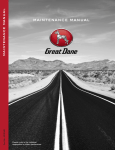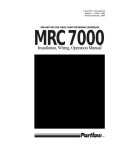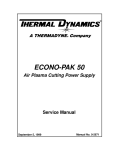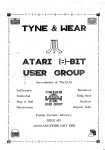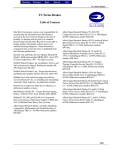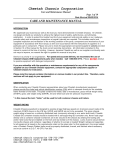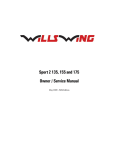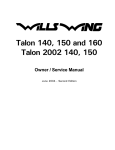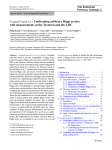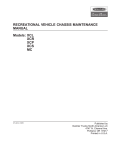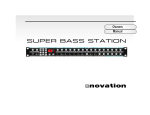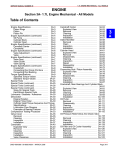Download Neway IFS Series Maintenance Manual
Transcript
IFS SERIES MAINTENANCE MANUAL IFS Series Independent Front Air-Ride Suspension Maintenance Manual XL-AK397-01 Holland Neway Technical/Customer Service Tel: 1-800-237-8932 Table of Contents Introduction . . . . . . . . . . . . . . . . . . . . . . . . . . . . . .2 Maintenance Schedule . . . . . . . . . . . . . . . . . . .3 Serial Number Tag Information . . . . . . . . . . . . .4 Vehicle Towing Information . . . . . . . . . . . . . . .5 Torque Specifications . . . . . . . . . . . . . . . . . .6-7 Pre-Operational Inspection . . . . . . . . . . . . . . . . . .8 Control Arm Bushing . . . . . . . . . . . . . . . . . . . .8 Tie Rod Ends . . . . . . . . . . . . . . . . . . . . . . . . . .9 Automatic Slack Adjusters . . . . . . . . . . . . . . . .9 Air Spring Adjustment . . . . . . . . . . . . . . . . . .10 Height Control Valve Adjustment . . . . . . . . . .10 Adjusting Suspension Ride Height . . . . . . . . .11 Type CR and IR Height Control Valves . . . .11-12 Lubrication . . . . . . . . . . . . . . . . . . . . . . . . . . . . .13 General . . . . . . . . . . . . . . . . . . . . . . . . . . . . .13 Greasing Knuckle Post Assembly . . . . . . . . . .13 Brake . . . . . . . . . . . . . . . . . . . . . . . . . . . . . . .14 Wheel Bearing and Hub Caps . . . . . . . . . . . . .14 Checking and Adjusting . . . . . . . . . . . . . . . . . . . .15 Wheel Bearings . . . . . . . . . . . . . . . . . . . . . . .15 Maximum Turn Angle . . . . . . . . . . . . . . . . . . .16 Inspection Before Alignment . . . . . . . . . . . . .17 Front Wheel Alignment . . . . . . . . . . . . . . . . . .18 Caster Angle Adjustment . . . . . . . . . . . . . . . .18 Camber Angle Adjustment . . . . . . . . . . . . . . .19 Adjusting Toe-In . . . . . . . . . . . . . . . . . . . . . .19 Part Replacement . . . . . . . . . . . . . . . . . . . . . . . .20 Parts Repair . . . . . . . . . . . . . . . . . . . . . . . . . .20 Parts Cleaning . . . . . . . . . . . . . . . . . . . . . . . .20 Upper and Lower Control Arm . . . . . . . . . .20-21 Shock Absorber Replacement . . . . . . . . . . . . .22 Air Spring Replacement . . . . . . . . . . . . . . . . .23 Knuckle Post Connection . . . . . . . . . . . . .23-24 Steering Gear Replacement . . . . . . . . . . . . . .25 Troubleshooting . . . . . . . . . . . . . . . . . . . . . . .26-27 Parts List Information . . . . . . . . . . . . . . . . . . .28-31 Introduction You must read and understand all of the safety procedures presented in this manual before starting any work on the IFS suspension. Proper tools must be used to perform the maintenance and repair procedures described in this manual. Many of these procedures require special tools. Failure to use the proper equipment could result in personal injury and/or damage to the suspension. IMPORTANT: Includes additional information that if not followed could lead to hindered product performance and/or product failure. CAUTION Used without the safety alert symbol, indicates a potentially hazardous situation which, if not avoided, may result in property damage. Safety glasses must be worn at all times when performing the procedures covered in this manual. Indicates a potentially hazardous situation which, if not avoided, may result in minor or moderate injury. Throughout this manual, you will notice the terms “NOTE, ” “IMPORTANT,” “CAUTION” and “WARNING” followed by important product information. So that you may better understand the manual, those terms are as follows: Indicates a potentially hazardous situation which, if not avoided, could result in death or serious injury. CAUTION WARNING NOTE: Includes additional information to enable accurate and easy performance of procedures. 2 IFS Series Suspension Introduction Table 1 - Maintenance Schedule Mileage in the Thousands (X 1,000) General Maintenance Service to be performed Control Arm Bushings Check for proper torque on bolts Upper and Control Lower Arms Inspect for contact between Control Arm and Mount Brkts X X X X X X X X2 Inspect for bushing wear X X X X X X X X2 Inspect ball socket end play X X X X X X X X2 Check for looseness of taper connection X X X X X X X X2 Check that cotter pin is installed X X X X X X X X2 Inspect slack adjuster for correct stroke X X X X X X X X2 Inspect for air leaks using soapy water solution X Inspect for proper clearance (1" minimum all around) X Check upper mount nut and lower mount bolt torque X Inspect for signs of chafing or wear X X X X X X X X2 Check for air line fitting torque X Inspect for air leaks using soapy water solution X Inspect for signs of bending, binding, or slippage X X X X X X X X2 X X X X X X X2 X X X X X X X2 12 Tie Rod Ends Brake System Air Springs Height Control Valve Linkage Shock Absorbers Steering Arms Wheels 24 36 X Check stud mount and lock nut torque X Inspect shocks for signs of fluid leak, broken eye ends, loose fasteners, or worn bushings X Check for proper torque on nuts X Inspect bearings for excessive radial play X 60 X Check bearing end play Check for proper torque on wheel nuts1 48 72 84 X X2 X2 X X Front Alignment Inspect toe-in3 Air Fittings and Air Lines Inspect for air leaks using soapy water solutions X Inspect airlines for signs of chafing, cracking, or wear X X X X X X X X X X 96 X X X X X X2 X2 X X2 1.Wheel nuts must be re-tightened to proper torque specifications as per the vehicle or chassis manufacturer's Owner Guide. 2.Continue to perform specified maintenance every 12,000 miles. 3.Toe-in should be inspected after vehicle completion by final stage manufacturer. IFS Series Suspension 3 Introduction (Continued) Serial Number Tag Location Serial Number Tag Description The IFS Series Suspension Serial Tag is attached to the forward front subframe bulkhead (Fig.1). Stamped on this tag are the suspension model and serial number and parts list number (Fig.2). The sample tag shown below will help you interpret the information on the Holland Neway Serial Tag. The model number is on the first line along with the suspension capacity. The second line contains the serial number and the third line has the parts list numbers (Fig. 2). This information will aid you when contacting the chassis manufacturer or Holland Neway. The serial number is used by Holland Neway for control purposes and should be referred to when servicing the suspension. NOTE: This manual applies to the suspension series shown on front cover. However, we urge you to reference your specific parts lists number, write that information below and use it when obtaining information or replacement parts. Holland Neway reserves the right to modify or change the suspension described in this manual, its specifications and its repair and maintenance procedures at any time without notice or incurring any obligation. Figure 2. - Holland Neway Serial Number Tag Example HOLLAND NEWAY INTERNATIONAL, INC MUSKEGON, MICH., U.S.A. MODEL NO. CAPACITY (LBS.) IFS-114-P 14,000 LBS. SERIAL NO. IF-0213021-CD PARTS LIST NO. 90547128 COVERED BY ONE OR MORE OF THE FOLLOWING PATENTS (OTHER PATENTS PENDING) 4,193,612 4,322,061 4,595,216 4,634,141 4,700,968 4,729,579 4,262,929 4,405,154 4,615,539 4,693,486 4,726,571 4,736,958 4,854,409 5,083,812 5,201,898 5,335,695 5,393,096 4,858,949 5,088,763 5,203,585 5,335,932 5,413,374 4,991,872 5,112,078 5,288,100 5,375,819 5,192,101 5,058,916 5,116,075 5,315,918 5,058,917 5,333,645 JAPAN PATENT 2038539 PART #93800269 6,116,626 MODEL NUMBER: SERIAL NUMBER: PARTS LISTS NUMBER: IN SERVICE DATE: The Parts List Number is directly related to Coach Builders IFS Bill of Material and will be most useful in determining proper replacement parts. Figure 1. - Serial Number Tag Location Serial Number Plate Location 4 IFS Series Suspension Introduction (Continued) Vehicle Towing Information BEFORE attempting any type of towing procedures the OEM/Coach Builder must be referred to for the recommended towing methods. NOTE: Before towing vehicle check with local authorities (Department Of Transportation) for permissible towing methods. Some States DO NOT permit towing vehicles by chains or towing straps. DO NOT attach tow apparatus (hooks, chains, straps, etc.) to Control Arms (upper or lower), Sway Bar, Brake Components, Tie Rods or Knuckle Post Assemblies (Fig. 4). WARNING Attaching towing equipment to improper locations and failure to utilize OEM/Coach Builder recommended towing methods could result in one or more of the following: • Damage to the suspension and/or vehicle. • Loss of vehicle control. • Possible disconnect from the vehicle. Figure 4. - Improper Tow Equipment Attachment Locations, DO NOT attach towing equipment to any of the identified components. Upper Control Arms Brake Chamber & Components Knuckle Post Assembly Tie Rod Tie Rod Lower Control Arms IFS Series Suspension 5 Introduction (Continued) Figure 4. - IFS Pre-Operational Torque Checklist Torque Specifications IMPORTANT: Most of the fasteners used in this suspension are graded fasteners. These fasteners have the strength and hardness properties required for their particular function. When replaced, they must be replaced with fasteners of the same grade, size and form as the original in order to prevent failure. 1 3 6 4 9 19 2 11 8 7 5 Table 2 - Torque Chart Item Fastener Size Bolt - (Dia. x Thd./Inch x Length) Nut - (Dia. - Thd./Inch) 7/8" - 9 x 3.5" Application 1 Steering Gear Attachment 2 Knuckle Post/Spindle Tapered Lock Pin 3 Upper Control Arm Inner Sub-Frame Connection 1" - 8 x 5" 4 Knuckle Post/Control Arm Connections 1 1/4" - 12 x 8.5" 5 Lower Control Arm Inner Sub-Frame Connection 5/8" - 11 x 3.5" 6 Shock Absorber Connections 3/4" - 10 x 3.5" 7 Steer Arm to Spindle Connections 1 3/8" - 12 8 Tie Rod Assembly Clamp Bolts 5/8" - 11 9 Steer Arm to Tie Rod Assembly 7/8" - 14 10 Brake Chamber to Brake Bracket 5/8" - 11 x 1.5" 11 *Wheel Spindle Nut/Wheel Bearing Adjustment 1 1/2" - 18 12 Pitman Arm Retaining Bolt (TRW Gear Only) 3/4" - 10 x 4" 13 N/S Pitman Arm Retaining Tab Lock (Sheppard Gear Only) 14 N/S Pitman Arm to Tie Rod Assembly 7/8" - 14 15 N/S Foundation S-cam Brake Assembly to Spindle 5/8" - 18 x 2.25" 16 N/S Air Spring Upper Mounting Nut (Air Inlet) 3/4" - 16 17 N/S Air Spring Upper Mounting Nut 1/2" - 13 18 N/S Air Spring Lower Attachment Nut 1/2" - 13 19 King Pin Caps w/Grease Fittings 20 N/S Steering Stop Jam Nut 5/8" - 18 21 N/S Sway Bar Attachments (Country Coach Models Only) 1/2" - 13 22 N/S Height Control Valve Bracket to Sub-Frame 1/2" - 13 x 1.5" 23 N/S Height Control Valve to Bracket (if applicable) 3/8" - 16 24 N/S Height Control Valve Linkage 1/4" - 20 Numbered items are called out in Figure 4. - IFS Pre-Operational Torque Check list. Item number plus N/S equals "Not Shown". 10 Fastener Grade Gr 5 Gr 8 Gr B Gr 8 Gr 5 Gr 5 Gr 5 Gr 5 Gr 8 Gr 8 Gr 8 Gr B Gr 5 Gr 5 Gr 5 Gr 5 19 9 Torque Specification Clean, Dry Threads** (Ft. Lb.) 400 - 450 55 - 60 450 - 550 630 - 770* 150 - 200 90 - 110 680 - 740* 50 minimum 125 - 135* 130 - 170 See Wheel Bearing Adj. 125 - 150 430 - 470 125 - 135* 220 - 260 30 - 40 30 - 40 30 - 40 68 - 82 90 - 110 40 - 50 70 - 80 20 - 30 5 - 10 * Indicates cotter pin installation necessary after torque attainment. ** Torque spec's do not take into consideration the utilization of anti-friction or anti-seize compounds. *** All torques listed are for tightening of the nuts unless otherwise noted. Figure 5. - Bolt Grade Markings & Lock Nut Grade Markings Grade Grade 1 or 2 6 Grade 5 Grade 8 IFS Series Suspension Lock Nut Grade B Lock Nut Grade C 3 Dots 6 Dots Identification Introduction (Continued) Torque Specifications Table 3 - Torque Chart Applications Brake Spider Mount Fastener Size Torque Sequence 5/8" - 18 Torque Specifications FT. LB. (Clean & Dry) 170 - 190 (1 & 2) Driver Side Hub Cap Bolt 5/16" - 18 Grade 5 20 - 30 (1) 1 1/8" - 16 (Stud Piloted) 450 - 500 (3) Wheel Nut M22 x 1.5 (Hub Piloted) (Dry Threads) IFS Series Suspension 7 Pre-Operational Inspection Introduction Control Arm Bushings & Connections IMPORTANT: Safety glasses must be worn at all times when performing the procedures covered in this manual. The control arm bushings must be inspected for wear. A thorough visual inspection of the suspension is necessary to ensure proper assembly and identify problem parts and loose fasteners before servicing. Perform all of the following during the inspection. • Operation - All components must be checked to assure that they move freely through the complete turning arch of the steering. WARNING Always use safety stands. Never work under a vehicle supported by a jack(s) only. Jacks can slip or fall over and cause serious personal injury. DO NOT place jacks or safety stands under the lower control arms to support the vehicle. Lower control arms are not stationary components and could move allowing the vehicle to drop causing serious personal injury. Inspection Procedures • Wheel Alignment - See page 3 for inspection intervals. See Wheel Alignment guidelines (page 18) if excessive steering effort, vehicle wander, or abnormal tire wear is evident. 1. Secure the vehicle by setting the parking brake and blocking the drive wheels. • Fasteners - Use a calibrated torque wrench to check that all fasteners are tightened to the torque specifications listed in Table 2 & 3 on pages 6 & 7. 3. Support the vehicle with safety stands. • Wear and Damage - Visually check suspension for broken or bent parts. All worn, damaged or out-of-spec components must be replaced. WARNING Altering or attempting to repair or modify a component can adversely effect the suspension strength and performance and could result in the loss of vehicle control. IMPORTANT: Repair or reconditioning of suspension components is prohibited. Most parts are heat treated and tempered and can not be welded, bent, heated or repaired in any way without reducing the strength or the life of the component thus voiding the warranty. Genuine component replacement only is allowed. 2. Jack the vehicle up to raise the front wheels off from the ground. 4. Remove the tires. 5. Look for bushing bulge between the upper and lower control arms and the sub-frame mounting brackets. Look for small rubber particles near the sub-frame mounting brackets (Fig. 6 & 7). If either condition is found, replace bushings. 6. Look for loose mounting bolts (8 places) in the upper and lower control arms (Fig. 6 & 7). Make sure that the mounting bolts are tight. A loose joint will result in wear between the bushing inner sleeve and the subframe mounting brackets. See Torque Specs on pages 6 & 7. NOTE: It is recommended that if one bushing is found to be worn, all control arm bushings must be replaced. See page 20 for bushing replacement. Figure 6. - Upper Control Arm to Sub-Frame Connection Refer to Part Replacement Instructions, pages 20-25. Refer to Parts List on pages 28 - 31 for identification of suspension components. Most parts are heat treated and tempered and cannot be welded, bent, heated or repaired in any way without reducing the strength or the life of the component thus voiding the warranty. 8 IFS Series Suspension Pre-Operational Inspection (Continued) Figure 7. - Lower Control Arm to Sub-Frame Connection 3. With the engine off remove the tie rod end ball stud from the taper mount and visually inspect both. If either of the mating tapers show distortion or wear, then both components must be replaced. See Torque Specs on pages 6 & 7. 4. With the engine off and the wheels straight ahead, grasp the tie rod near its end (Fig. 8) and try to move the socket in all directions. Be sure to only apply hand pressure to the tie rod. Lower Control Arm Mounting Bolts (8 total) Tie Rod Ends 5. The side-to-side movement (Arrows A & B Fig. 8) of the socket must be measured with a scale. If it moves more than 1/8 inch (3mm) then replace the tie rod end immediately. If there is detectable movement, but it is less than 1/8 inch (3mm) then the tie rod end should be replaced before it gets worse. 6. Check dust boot for damage and replace if necessary. WARNING DO NOT use wrenches or other similar objects to apply leverage when inspecting tie rod sockets. This could cause incorrect results and damage components leading to loss of steering control. Inspection Procedure 1. Secure the vehicle by setting the parking brake and blocking the drive wheels. 2. Turn the engine on and rock the steering wheel lightly. Observe any looseness in the mating tapers or movement of the stud nuts at both ends of the tie rod (Fig. 8). If looseness is found, go to step 3, otherwise move forward to step 4. Automatic Slack Adjusters and Brake System Automatic Slack Adjusters The suspension system is equipped with slack adjusters for steer axles. For inspection and adjustment procedures refer to the slack adjuster manufacturers technical service guidelines. Brake System The suspension system comes equipped with Eaton 15 x 4 or 16 1/2 x 5 S-cam brake assemblies (Fig. 9). For service procedures refer to Eaton maintenance manual #BRSM-0033. Figure 8. - Tie Rod End Inspection Figure 9. - Brake System A B Check for Side-to-side movement IFS Series Suspension 9 Pre-Operational Inspection (Continued) ABS Sensor and Tone Ring Height Control Valve Please refer to Coach Manufacturer's Manual for sensor type and proper maintenance guidelines. Inspection Procedures Shock Absorbers Inspection Procedure Visually check for shock absorber oil leakage, bent, missing or broken components, excessive corrosion, or worn bushings. If you find any of the above problems replace the shock. Air Spring Air Spring Inspection Procedures 1. Secure the vehicle by setting the parking brake and blocking the drive wheels. 2. Remove any build-up of foreign material present around the air spring piston. The air spring should be checked (externally) for irregular wear, over extension or cracking. 1. Check the height control valve and linkage assembly for damaged parts and replace them (Fig. 11). 2. Measure the ride height of the suspension (Fig.12). Measure the distance from the bottom of the chassis frame rail to the center of the wheel. An alternate measurement may be taken between the center of the shock mounts. See Chassis builder manufacturer for correct ride height. The vehicle can be empty or loaded while taking these measurements. NOTE: An alternate way to measure ride height is to measure from centerline CL of spindle to ground “A” dim. and from frame rail to ground “B” dim. Then subtract “A” from “B” to establish ride height measurement (Fig. 12). Figure 11. - Height Control Valve Linkage Assy. (Type IR HCV Shown) 3. Make sure contact does not exist between the air lines and the outside diameter of the air spring. Re-secure air lines to prevent contact as needed. Check for leaks along the air line and fittings with soapy water solution. If leaks are found replace air line and/or fittings. 4. Make sure the air spring, while energized with air, has a minimum of 1 inch clearance around its circumference (Fig. 10). 5. Refer to Air Spring Manufacturers Preventative Maintenance Checklist for additional formation. Figure 10. - Air Spring Check Control Arm Height Control Valve (IR shown) 1" Min. Clearance Required Around Air Spring 10 Linkage Assembly Lower Linkage Brackets (connection could vary per vehicle) IFS Series Suspension Pre-Operation Inspection (Continued) Figure 12. - Ride Height Measurement Bottom of Chassis Frame Bottom of Chassis Frame Ride Height CL "B" "A" Ground Line Adjusting Suspension Ride Height NOTE: Before performing any adjustment or maintenance, identify the style of the height control valve. The IFS suspension can be equipped with either a Holland Neway Type CR (Controlled Response) or a Type IR (Immediate Response) height control valve. Follow the proper adjustment procedures for your height control valve. The height control valve and linkage should be checked frequently for proper clearance, operation and adjustment. NOTE: Improperly adjusted ride height will result in incorrect alignment measurements and may result in poor ride quality and abnormal tire wear. Check ride height prior to front suspension alignment. The front suspension ride height is the distance between the bottom of the chassis frame rail to the center of the wheel spindle (Fig.12). Properly adjusted ride height results in correct suspension travel and alignment. DO NOT adjust the ride height to adjust chassis rake angle. Adjustment Procedure (Type CR Valve) 2. Pressurize the air system with a constant supply of air in excess of 105 P.S.I.G. All air springs should inflate and be set to the chassis manufacturers ride height. 3. Make sure the rear suspension is adjusted to the correct ride height per the vehicle manufacturers specifications. 4. Check the height control valve plumbing for air leaks using a water/liquid soap solution. 5. Make sure shock absorbers are mounted securely and mounting connections are not bent. 6. If ride height is incorrect, adjust ride height by the adjusting lock nut (Fig.13). Loosen the 1/4" nut, push up adjusting block to increase ride height and pull down to decrease ride height. Re-tighten 1/4" lock nut to 15-25 in. lbs. NOTE: Valve has a built in time delay feature; therefore, several seconds may elapse prior to air flow. NOTE: If proper ride height is not obtained or air springs do not inflate properly, check air pressure and pressure protection valve, check for proper piping and check Type CR height control valve (Fig.13) and repeat above steps. Then if not functioning properly, contact Chassis Manufacturer or Holland Neway Service Department. Figure 13. - Type CR Height Control Valve Adjustment. Intake (Up) Control Arm 1/4" Adjusting Lock Nut Adjusting Block Exhaust (Down) Exhaust 1. Park the vehicle on a level surface and secure the vehicle by setting the parking brake and blocking the drive wheels. "Out" To Air Spring "In" Air Supply Locating Pin Manufactured Date Code IFS Series Suspension 11 Pre-Operational Inspection (Continued) Figure 14. - Type IR Height Control Valve Adjustment Adjustment Procedure (Type IR Valve) 1. Prior to adjustment, the vehicle must be in an unloaded condition and on a level floor. 2. Pressurize the air system with a constant supply of air in excess of 105 P.S.I.G. (5.5 Bar) All air springs should inflate and be a proper ride height. 3. If ride height is off, adjust height control valve by loosening the hose clamps (Fig. 14) on the universal connection fitting. Push up to raise ride height and push down to lower ride height (Retighten hose clamps after adjustment). Hose Clamps Universal Connection (Valve Adjustment) NOTE: If proper ride height is not obtained or air springs do not inflate properly, check air pressure and pressure protection valve, check for proper piping and repeat above steps. Then if not functioning properly, contact the chassis manufacturer or Holland Neway Service Department. Figure 14A. - Type IR Height Control Valve Adjustment NOTE: The Type IR-HCV can be installed with the control arm in either left-hand or right-hand position. Refer to Form 94100535 or contact Holland Neway Service Dept. for information. 12 IFS Series Suspension Lubrication Table 4. - Lubrication Specification and Intervals Component Service Interval Change Interval On Ends of Tie Rods, Relay Rod, Drag Link Which ever comes first: 50,000 miles (80,000 kilometers) or once a year. Brake S-Cam Tube and Automatic Slack Adjuster1 Which ever comes first: Brakes relined. 50,000 miles (80,000 kilometers) or once a Year. Wheel End 1000 miles (1600 kilometers) Check fluid level 1 Lubricant Specification Multi-Purpose Chassis Grease N/A NLGI Grade 1 or 2 Lithium Base Multi-Purpose Chassis Grease N/A NLGI Grade 1 or 2 Lithium Base Which ever comes first: Seals replaced, brakes relined, 100,000 miles (160,000 km), or once a year. Gear Oil SAE 80W/90 or equivalent Moly-disulfide type grease is not recommended since it may lower friction capabilities in the adjusting clutch parts of the automatic slack adjuster. General Lubrication Recommended Procedure It’s important to use proper lubrication practices to gain maximum service life for your Holland Neway Independent Front Suspension. NOTE: The specified grease is lithium based NLGI Grade 2. IMPORTANT: DO NOT mix 2 lubricants of different grades. DO NOT mix mineral and synthetic lubricants. Parts may experience premature failure. Different brands of the same grade may be mixed. IMPORTANT: Never mix oil bath and grease packed wheel ends. Parts may experience premature failure. Greasing Knuckle Post Assembly The knuckle post assembly (Fig. 15) is designed to be a factory installed assembly that is permanently greased for the life of the vehicle. The joints are sealed by four (4) O-rings on each knuckle post assembly designed to hold in grease, under pressure, while preventing outside contamination. Although greased at the factory, two (2) Zerk style grease fittings have been installed on Figure 15. - Knuckle Post Assembly each knuckle post assembly, Upper Grease Fittings (Fig. 15). This allows reapplication of grease after maintenance or replacing components. IMPORTANT: While injecting grease always maintain visual sight of O-rings. At first sign of O-ring movement stop pumping grease. Slight movement indicates a "full" grease cavity. IMPORTANT : DO NOT over pump grease into grease fittings. The grease gun type must not exceed 250 psi max. If a high-pressure grease gun is used it could cause an O-ring to extrude out of the groove and degrade its function. This is usually indicated by a large amount of grease extruding from the O-ring joints and the O-rings being visually distorted or damaged. 1. Using a proper grease gun (250 psi max.), pump grease into grease fitting until slight O-ring movement has occurred. 2. Look to ensure O-rings are not distorted or damaged. a. If distorted or damaged replace rubber O-ring seals. b. If not distorted or damaged, knuckle post assembly is properly lubed. 3. Repeat for both upper & lower fittings on each knuckle post assembly. Lower Grease Fitting IFS Series Suspension 13 Lubrication (Continued) Grease Fittings Figure 18. - Lubricate Automatic Slack Adjuster Tie Rods Ends NOTE: Before servicing, review lubricant specifications and interval requirements, Table 4. 1. Ensure grease gun is filled with proper lube. 2. Apply lubricant to grease fittings until new lubricant discharges from the dust boot (Fig. 16). Figure 16 . - Lubricate Grease Fittings Slack Adjuster Zerk location Wheel Bearings and Hub Cap Tie Rod Grease Fittings (4 total) on Tie Rods. Brake S-Cam Tube and Automatic Slack Adjuster 1. Apply lubricant to the S-cam tube until new lubricant discharges from the S-cam bushing seal next to the automatic slack adjuster (Fig.17). 2. Apply lubricant to the automatic slack adjuster until new lubricant discharges from the cone clutch adjacent the adjusting hex nut (Fig. 18). Figure 17. - Lubricate S-Cam Tube NOTE: Before servicing. Review lubricant specifications and interval requirements, Table 4 page 13. Clean the hub cap window with mild soap and water only. Aromatic solvents will impair the transparency of the window. 1. Check oil level through the hub cap window. If below the “add” level line remove the pipe plug and fill with recommended oil to the “full” level (Fig. 19). Add oil slowly since the heavy weight oil will settle slowly. 2. Visually check the hub cap for external oil leaks. Usually the vent plug will drip a small amount of oil. Oil leaks in other places should be fixed by replacing either the hub cap seal, window gasket, or tightening the pipe fill plug. Figure 19. Wheel Bearing Oil Level Grease Fittings (one per adjuster) 14 S-cam Bushing Seal Hub Cap Window IFS Series Suspension Checking and Adjusting Wheel Bearings Preparation 1. To prevent vehicle movement. Set the parking brake and block the drive wheels. WARNING Always use safety stands. Never work under a vehicle supported by a jack only. Jacks can slip or fall over and cause serious personal injury. DO NOT place jacks or safety stands under the lower control arms to support the vehicle. Lower control arms are not stationary components and could move allowing the vehicle to drop causing serious personal injury. 2. Raise the vehicle until the front wheels are off the ground. Then support the vehicle with safety stands. 3. Remove the vent plug from the hub cap. Adjustment 1. Attach a dial indicator with a magnetic base to the face of the hub, wheel, or brake drum. If the wheel is removed, the dial indicator may also be attached to the bottom of the brake drum. 4. Place a pail beneath the hub to catch the oil. Rotate the hub so that the hubcap drain plug is facing upwards. Remove the drain plug from the hubcap and store it for installation later. 5. Turn hub so that the drain hole faces downward and drain the oil from the hub cavity. Wait for most of the oil to drain before continuing to the next step. 6. Remove the hub cap, hub cap bolts, and gasket. If not damaged the gasket can be re-installed later. To prevent component contamination place them in a clean container. Note that solvents could damage the hub cap window. CAUTION To avoid damage removing or installing the inner and outer spindle nuts DO NOT use an impact driver. Use a torque wrench with the proper socket. 7. Screw wheel bearing adjusting nut against the thrust washer while wheel is rotated. Be sure there is sufficient clearance between brake shoe and drum so that there will be no brake drag. 8. Tighten nut to 200 ft.-lbs. of torque while rotating wheel in both directions. 2. Place the tip of the dial indicator on the center of the steering knuckle spindle. Then set the dial indicator on zero (Fig. 20). 9. Back off nut one full turn. Figure 20. Wheel End Play Measurement 11. Back off nut 1/6 to 1/4 turn. 10. Tighten nut to 50 ft.-lbs. of torque while rotating wheel in both directions. 12. Check adjustment, making sure wheel rotates freely. With a dial indicator, place magnetic base on wheel and pointer on end of spindle. Grasp wheel of hub and drum, and with a push/pull action, record amount of axial movement. 13. If movement is greater than .005, repeat adjustment procedure. If no movement is recorded, repeat adjustment. NOTE: Do not push/pull at the top/bottom of the tire, drum, or hub. This will not yield a true measurement of the end play. 3. Measure the end play by pushing/pulling on each side of the tire, drum, or hub at the same time while observing the dial indicator. The end play is the total travel observed. If the end play is not within .001-.005 inch adjust the wheel bearings per steps 4-10. Otherwise no adjustment required. Go to step 17. 14. If movement is between .001 - .005 inch, secure with new cotter pin. Replace hub cap, refer to Table 3 on page 7 for proper torque specifications. 15. Fill the hub cavity with the prescribed amount and type of lubricant. See Table 4 on page 13. for lubricant specifications. 16. Install drain plug. 17. Repeat for other wheel. IFS Series Suspension 15 Checking and Adjusting (Continued) Maximum Turn Angle Adjustment Figure 21. - Steering Arm Stop Bolt IMPORTANT: DO NOT adjust angle more than 50º. An over adjustment of the turn angle can cause damage to system components. 1. Check the turn angle if the front tires rub against the frame, suspension, body, or if the steering gear has been serviced. Use an alignment machine to check the angle. NOTE: Follow the alignment machine manufacturers alignment procedure. 2. The maximum turn angle is controlled by the steering stop bolt located on the spindle assembly, (Fig. 21). If the stop bolt is bent, broken or missing, replace the stop bolt(s) or jam nut(s) and follow the procedure below for adjustment. Inspect other suspension components for damage. 3. While adjusting the steering stop(s), the steering gear poppet valves may also need readjustment. Refer to Steering Gear Manufacturers Service Manual for readjusting the poppets. IMPORTANT: In power steering systems, hydraulic pressure should relieve or “drop off” when the turned wheels approach the steering stops in either direction. The front suspension components may be damaged if the pressure does not relieve. WARNING Always use safety stands. Never work under a vehicle supported by a jack only. Jacks can slip or fall over and cause serious personal injury. DO NOT place jacks or safety stands under the lower control arms to support the vehicle. Lower control arms are not stationary components and could move allowing the vehicle to drop causing serious personal injury. Steering Arm Stop Bolt IMPORTANT: Unequal toe-in side to side or an off-center steering gear can result in unequal turn angles and steering pull while steering straight ahead. The drag link length may be adjusted to attain steering gear on center condition while maintaining equal toe-in side to side. Failure to obtain equal toe-in or on-center steering gear may result in premature tire wear. IMPORTANT: DO NOT adjust the length of the drag link or tie rods to center the steering wheel. This can cause the steering gear to become off center and result in premature tire wear. Adjustment 1. Turn the steering wheel until the steering arm contacts the stop bolt or stops turning (Fig.21). Measure the turn angle of the wheel on the same side as the turn (i.e. inside wheel). 2. If the wheel turn angle differs from the chassis manufacturer guidelines, adjust as follows. 3. Loosen the stop bolt jam nut. 4. Rotate the stop bolt until the correct wheel turn angle is achieved and the bolt head contacts the steering arm. 5. Tighten the jam nut to 90-110 ft. lbs. See Torque Specs on pages 6 & 7. NOTE: Refer to OEM Chassis Manufacturer for proper alignment procedures. 16 IFS Series Suspension Checking and Adjusting (Continued) IMPORTANT: After readjustment of the steering stop(s) make sure the steering poppets are reset properly and the front tires DO NOT contact the frame, suspension, or body. A 1/2" minimum clearance between the air spring and brake dust cover is required. Failure to maintain 1/2" clearance may result in air spring and/or tire damage. 6. Repeat Adjustment Steps 1 thru 5 for turning the opposite direction. Front Wheel Alignment WARNING Always use safety stands. Never work under a vehicle supported by a jack only. Jacks can slip or fall over and cause serious personal injury. DO NOT place jacks or safety stands under the lower control arms to support the vehicle. Lower control arms are not stationary components and could move allowing the vehicle to drop causing serious personal injury. Inspection Before Alignment Before conducting front wheel alignment measurements check the following requirements. Wheels and Tires 1. Inflate the front tires to the appropriate pressure based on the wheel loading. 2. The front tires need to be the same size and type. 3. Make sure the wheel nuts are tightened to the specified torque of 450-500 ft.-lbs. See Torque Specs on pages 6 & 7. NOTE: Refer to OEM Chassis Manufacturer for proper alignment procedures. 4. Check if the wheels are balanced. Use standard procedures. Front Suspension 1. Torque all fasteners to the right specifications. NOTE: Refer to OEM Chassis Manufacturer for proper alignment procedures. Follow the manufacturer's procedures to prepare the vehicle for front and rear wheel alignment measurements. IMPORTANT: Holland Neway recommends that professional alignment equipment be used to measure the wheel alignment characteristics: caster, camber, and toe-in. The equipment must also be properly calibrated. Only qualified personnel should conduct the wheel alignment measurements. IMPORTANT: Toe-in of the front wheels should be checked every 24,000 miles or 2 years. If the vehicle does not steer correctly or the front tires develop an abnormal tire wear pattern, the caster, camber, and toe-in should be measured and adjusted. Toe-in usually has the largest effect on tire wear. See Maintenance Schedule Chart on page 3. 2. Check the suspension ride height and adjust as needed to the specified height. NOTE: Maximum wheel turn angle should also be checked and adjusted (refer to page 16). 3. All worn ball joints, tie rod ends, steering arm bearings, control arm bushings, and damaged suspension components need to be replaced. NOTE: Adjusting the length of the drag link or tie rods to center the steering wheel could cause the steering gear to become off center. 4. Inspect for wear and replace and tighten all loose ball joint and tie rod end tapered connections, tie rod end jam nuts, steering arm mounts, and chassis steering system components. 5. Check the wheel bearings and adjust as needed. 6. Inspect all shock absorbers for possible wear and damage. IFS Series Suspension 17 Checking and Adjusting (Continued) Caster Angle Adjustment WARNING Adjusting the ride height or altering components to adjust the suspension caster is strictly prohibited. Alteration of components could result in loss of vehicle control. Table 5 - Nominal Caster Values Suspension Parts List No. Degrees 90546687 3.0° ± 1° 90547128 4.5° ± 1° 90547129 4.5° ± 1° 90547183 4.5° ± 1° 90547185 4.5° ± 1° Caster is pre-set at the factory. NOTE: Caster is preset at the factory and should not need to be adjusted. If adjusting is needed, the camber adjuster shims can be used for caster adjustment. By offsetting the number of shims on the front lower control arm connection to the number of shims on the rear lower control arm connection (Fig. 22 & 24), a change in caster will occur. NOTE: The knuckle post casting has a large embossed number near the king pin hole. This number designates the pre-set caster angle (Fig. 23). Figure 23. - Embossed Number Figure 22. - Caster Angle Adjustment Front Lower Arm Connection 18 Rear Lower Arm Connection IFS Series Suspension Embossed number on knuckle post designates pre-set caster angle Checking and Adjusting (Continued) Camber Angle Adjustment 1. Set park brake and block rear tires. 2. Raise front of vehicle off ground and support with safety stands. WARNING Adjusting the ride height or altering components to adjust the suspension camber is strictly prohibited. Alteration of components could result in loss of vehicle control. Camber is the angle of the tire with respect to the ground. Camber is “positive” when the distance between the top of both wheels is more than the distance at the ground. NOTE: A small amount of positive camber is built into the suspension because camber changes with load and chassis roll. NOTE: The camber of the suspension is affected by the ride height of the suspension. If the ride height is set too high then the camber measurement will be more positive. Table 6 - Nominal Camber Values Left Unloaded +1/4°(+1/4°) Loaded +1/4°(+1/4°) Right +1/4°(+1/4°) +1/4°(+1/4°) 3. Support front tires with safety stands. 4. Loosen all lower control arm mounting bolts (4) at the sub-frame. (2) bolts per lower control arm bushing (Fig. 24). 5. Add/remove shims between bushing bar pin and subframe. One .06" shim per bolt 4 places = .1° of camber adjustment. Add to increase camber and remove to reduce camber (Fig. 24). 6. Tighten bolts to 150-200 ft. lbs. See Torque Specs on pages 6 & 7. 7. Remove safety stands and lower vehicle. Make sure the suspension is at the proper ride height (refer to manufacturers ride specification). 8. Remeasure the camber and readjust as needed. Adjusting the Tire Toe-ln IMPORTANT: Nearly all tire wear is caused by incorrect toe-in settings. Holland Neway does not recommend altering components to adjust the suspension toe-in. Toe-in must be set by adjusting the tie rod lengths only. WARNING Figure 24. - Camber Angle Adjustment Adjusting the ride height or altering components to adjust the tire toe-in is strictly prohibited. Alteration of components could result in loss of vehicle control. NOTE: Toe-in is the measurement of the distance between the front and the rear of the two front tires. When the front distance is less than the rear distance, the wheels are "toed-in”. Toe-in is designed into the suspension to stop the tendency of the tires to “toe-out” when the vehicle is driven straight ahead. Shims Mounting Bolt IFS Series Suspension 19 Checking and Adjusting (Continued) Figure 25. - Tie Rod Measurement IMPORTANT: The following repair methods and actions are NOT allowed on IFS suspension components; including rod assemblies, ball joints, and subframe. • NO welding that involves the steering knuckles, steering arms, lower control arms, tie rod assemblies, hubs, brakes, or brake drums. • NO bending (hot or cold) of the spindle assembly, steering arms, upper and lower control arms and tie rod assemblies. Tie Rod Length • NO drilling out of the control arm and steering arm mounting holes and/or the ball stud tapered holes. Toe-in Specifications = 1/32" +- 1/32" 1. Use a professional alignment system to determine if toe-in adjustment is needed. If adjustment is needed follow Steps 2 through 6. 2. Measure the length of both tie rods (Fig. 25). If the lengths are not within 1/8" of each other the tie rods must be adjusted. Tie rods are properly adjusted if found to be within the 1/8" measurement. 3. Block rear wheels. 4. Raise front end of suspension and support with safety stands. 5. Loosen tie rod clamps bolts and adjust tie rod length as needed. 6. Re-tighten tie rod clamp bolts to torque specs listed on page 6. 7. Lower vehicle and remeasure (Fig. 25). Repeat procedures as necessary. PARTS REPLACEMENT WARNING Altering or attempting to repair or modify a component can adversely effect the suspension strength and performance and could result in the loss of vehicle control. IMPORTANT: Repair or reconditioning of suspension components is prohibited. Most parts are heat treated and tempered and can not be welded, bent, heated or repaired in any way without reducing the strength or the life of the component thus voiding the warranty. Genuine component replacement only is allowed. 20 • NO spray welding of bearing diameters on the spindle assembly, steering arm bores and pivot tube. Spray welding of tapered holes or ball studs for ball joint and tie rod ends. • NO milling/machining of any component is not allowed. The only exception is the honing of the control arm bushing bores to remove any burrs. IMPORTANT: DO NOT apply oil or corrosion preventative to the brake linings, brake drums or bushings. CAUTION Vehicle air supply system must be completely exhausted (dumped). Failure to exhaust before servicing vehicle could result in sudden component movement resulting in personal injury. Upper and Lower Control Arm Bushing Replacement Inspect the control arms and mounts for damage. If damage is found replace the complete control arm bushing assembly. NOTE: Holland Neway recommends replacing the bushings and mounting fasteners in all of the control arms at the same time. CAUTION Using a cutting torch to remove the control arm bolts will permanently damage control arm bushings and could result in subframe damage. IFS Series Suspension Part Replacement Preparation 1. Apply the parking brake and block the drive wheels to prevent vehicle movement. 7. Set control arm into its mount location. Place the control arm mount bolts into subframe snug tight. 8. Reconnect knuckle post to the outer end of the upper control arm. WARNING Always use safety stands. Never work under a vehicle supported by a jack only. Jacks can slip or fall over and cause serious personal injury. DO NOT place jacks or safety stands under the lower control arms to support the vehicle. Lower control arms are not stationary components and could move allowing the vehicle to drop causing serious personal injury. 2. Raise the vehicle front wheels off the ground and support with safety stands. 9. Reconnect the height control valve linkage to the knuckle post bracket. 10. Set Suspension to proper ride height. 11. Torque the upper control arm bolts to 450-550 ft. lbs. See Torque Specs on pages 6 & 7. IMPORTANT: IFS suspension must be realigned after control arm/bushing replacement. Figure 26. - Upper Control Arm Removal 3. Remove the front tires. Disconnect the Height Control Valve (HCV) linkage from the lower bracket (Fig. 11 - page 10). Upper Control Arm 1. Use a portable crane or jack and support the steering knuckle prior to disconnecting it from the control arm or removing the control arm with the steering knuckle attached. The knuckle post assembly is heavy and unbalanced and must be supported properly. CAUTION Upper Control Arm Bolts Lower Control Arm Failure to properly support the knuckle post assembly could result in personal injury to hands or feet. 2. Detach the upper control arm from the knuckle post. NOTE: DO NOT press on center metal core of bushing; apply load to outer metal casing of the bushing. 3. Remove the upper control arm mount bolts and remove the upper control arm (Fig. 26). 4. Support the control arm properly during bushing removal and replacement. Bushing hole of the control arms should be free of any burrs before replacing new bushings. 5. Using a hydraulic press with a 15 ton capacity, push bushing out of the control arm housing while supporting it securely. 6. Using the same hydraulic press from Step 5, push new bushing back into the control arm housing while supporting it securely. 1. Use a portable crane or jack and support the steering knuckle prior to disconnecting it from the control arm or removing the control arm with the steering knuckle attached. The knuckle post assembly is heavy and unbalanced and must be supported properly. CAUTION Failure to properly support the knuckle post assembly could result in personal injury to hands or feet. 2. Detach the lower control arm from the knuckle post assembly. 3. Remove the sub-frame control arm assembly mounting bolts. NOTE: DO NOT press on center of bushing; apply load to metal casing of bushing. IFS Series Suspension 21 Part Replacement (Continued) Figure 27. - Lower Control Arm Bushings Shock Absorber Replacement WARNING Shock absorber is “gas pressurized” DO NOT puncture of expose to excessive heat, serious personal injury can result. Preparation Apply pressure to outer metal casing of bushing when removing or replacing. 1. Apply the parking brake and block the drive wheels to prevent vehicle movement. Removal 1. Remove the 3/4-10 lower shock absorber mounting bolt from the Knuckle Post Shock Bracket (Fig. 28). 4. Using a hydraulic press with 15 ton capacity, support and secure control arm and push bushing out of the control arm housing (Fig. 27). Figure 28. - Shock Absorber NOTE: Be certain to apply pressure to outer metal casing of bushing when removing or replacing (Fig. 27). 5. Bushing hole of the control arms should be free of any burrs before replacing new bushings. 6. Using the same hydraulic press from step 3, push new bushing back into the control arm housing while supporting it securely. 7. Place the control arm in its mount location and install the control arm mount bolts into subframe snug tight. 8. Reconnect lower control arm to the knuckle post assembly. 9. The control arm should be supported in such a way such that it is at ride height, then torque the bolts to the recommended torque specs. See Torque Specs on pages 6 & 7. NOTE: Improperly adjusted ride height will result in incorrect alignment measurements and may result in abnormal tire wear. Check ride height prior to front suspension alignment, see pages 10 - 12. 2. Remove the 3/4-10 upper shock absorber mount bolt (Fig. 28). Installation 1. Install the shock absorber into the upper mounting bracket and secure with mounting bolt. 2. Place the shock absorber into lower mounting bracket and secure with mounting bolt. Wheel Bearing, Oil Seal, and Hub Cap Replacement See Coach Manufacturer's Service Manual for replacement guidelines. 22 Shock Absorber Mounting Bolts 3. Torque bolts to recommended specifications. See Torque Specs on pages 6 & 7. IFS Series Suspension Part Replacement (Continued) Installation Air Spring Replacement IMPORTANT: When replacing the air spring, make sure you use the correct replacement. Using an air spring that is not recommended by Holland Neway may be detrimental to vehicle ride and handling. 1. Mount the air spring to the knuckle post mounting plate. Torque the bolts to 30-40 ft.-lbs. See Torque Specs on pages 6 & 7. Preparation 2. Assemble the nuts and washers that connect the air spring to the upper air spring mount on the subframe. Torque the nuts to 30-40 ft. lbs. See Torque Specs on pages 6 & 7. 1. Apply the parking brake and block the drive wheels to prevent vehicle movement. 3. Install connection fitting into the air spring. Use Permatex or equivalent thread sealant. 2. 4. Connect air line to the air spring. Raise the vehicle until the front wheels are off the ground. Then support the vehicle with safety stands. DO NOT place jacks or safety stands under the lower control arms to support the vehicle. WARNING Always use safety stands. Never work under a vehicle supported by a jack only. Jacks can slip or fall over and cause serious personal injury. DO NOT place jacks or safety stands under the lower control arms to support the vehicle. Lower control arms are not stationary components and could move allowing the vehicle to drop causing serious personal injury. 3. Remove the front tires. Disconnect the Height Control Valve (HCV) linkage from the lower connection bracket (Fig. 11 - page 10). Removal 1. Remove air line at the air spring, then remove the connection fitting. 2. Remove all nuts and washers from the upper air spring mounting studs. 3. Remove bolts that secure the air spring piston to the knuckle post mounting plate (Fig. 29). 4. Remove the air spring. Figure 29. - Air Spring Replacement Upper Air Spring Mounting Studs 5. Lower vehicle frame and inflate the air springs. 6. Use water/liquid soap spray to check air fittings for leaks. Knuckle Post Connection Replacement IMPORTANT: The Holland Neway IFS utilizes precision roller bearings at each (upper and lower) knuckle post connection. This connection is very robust and tightly toleranced for ease of assembly and repair. Care should be taken to insure the machined surfaces of the control arms and bearing races are protected from damage. If a bearing element needs replacement, it is strongly suggested the outer bearing race be replaced at the same time. Removal 1. Apply the parking brake and block the drive wheels to prevent vehicle movement. 2. Raise the front wheels off the ground and support with safety stands. DO NOT support the vehicle with jacks or stands under the control arms. WARNING Always use safety stands. Never work under a vehicle supported by a jack only. Jacks can slip or fall over and cause serious personal injury. DO NOT place jacks or safety stands under the lower control arms to support the vehicle. Lower control arms are not stationary components and could move allowing the vehicle to drop causing serious personal injury. Air Spring Piston 3. Remove the front tires. Disconnect the Height Control Valve (HCV) linkage from the lower connection bracket (Fig. 11 - page 10). Knuckle Post Mounting Plate 4. Remove bolts that secure the air spring piston to the knuckle post mounting plate. IFS Series Suspension 23 Part Replacement (Continued) 5. Use a portable crane or jack and support the steering knuckle post assembly at its lowest position prior to disconnecting it from the control arm or removing the control arm with the steering knuckle attached. The knuckle post assembly is heavy and unbalanced and must be properly supported. CAUTION Failure to properly support the knuckle post assembly could result in personal injury to hands or feet. 6. Remove knuckle bolt cotter pins. Loosen the knuckle bolt nuts and remove. 7. Pull the knuckle post bolt assemblies from the upper and lower control arm connections and completely remove it. 8. Swing the knuckle post outward or swing the control arms (upper or lower) aside until full access is available to the upper and lower bearings. NOTE: Care should be taken to insure the roller bearing elements do not fall out by slowly moving the knuckle post or control arms aside. 9. Remove the roller bearing elements and the O-rings from both sides of the knuckle post opening (Fig. 30). Figure 30. - Knuckle Post Connection Replacement Cylinder Bolt Sleeve Roller Bearing Outer Bearing Race 10. If the outer bearing race needs to be removed; a long flat nosed punch will be required to gently tap out the outer race from the back side of the race. NOTE: The area will likely be filled with grease and the grease will need to be removed to allow a clear view of the inside inner edge of the bearing cups. 11. Remove the cylindrical bolt sleeve. Installation 1. Place the cylindrical bolt sleeve(s) in the knuckle post opening. 2. If removed, install new outer bearing races into the knuckle post opening(s) by gently tapping in the race with a block of wood placed between the race and the hammer (Fig. 30). NOTE: It is very important to completely seat the bearing race in the knuckle post receptacle. A 0.002" feeler gage should not fit between the backside of the race and the mating shoulder in the knuckle post. IMPORTANT: Care should be taken to insure the bearing race surface is not damaged. 3. Prepack the roller bearing elements with grease and apply grease to the outer bearing races and machined faces of the control arms. 4. Place the roller bearing elements and O-ring in each side. Typically, the grease will hold the roller elements in place until the control arms are moved into place. 5. Swing the knuckle post or control arm ends into alignment with the bore of the tapered roller elements. NOTE: Care should be taken to insure the O-ring does not get pinched between the knuckle post, control arm, and roller element bore. 6. Insert the knuckle post bolt assembly through the connection. O-Ring 7. Install nut and torque to 630-770 ft. lbs. Install cotter pin. See Torque Specs on pages 6 & 7. Roller O-Ring Bearing 24 Cylinder Bolt Sleeve Outer Bearing Race 8. Re-lubricate connection per lubrication instructions on page 15. 9. Replace bolts that secure the air spring piston to the knuckle post mounting plate. IFS Series Suspension Part Replacement (Continued) Steering Gear Replacement Procedure NOTE: Not all IFS units are fitted with a steering gear supplied by Holland Neway. The approximate weight of each gear with fluid is between 80 and 100 lbs. and may require some external means to support it during removal. See chassis manufacturer for detailed steering gear information. IMPORTANT: Steering gear case is very heavy and a proper support device should be used during removal. 5. Disconnect all hydraulic lines and the steering input shaft to the gear case and remove the 7/8" attaching fasteners. It is necessary to support the steering gear case with a support device due to its weight. 6. Remove the steering gear case. Installation 1. Install and support the steering gear case in position on the underside of the sub-frame mounting plate. 2. Install the 7/8" fasteners and torque to 400-450 ft. lbs. See Torque Specs on pages 6 & 7. CAUTION Failure to properly support the steering gear could result in personal injury to hands or feet. 3. Connect the steering input shaft to the steering gear case input spline. 4. Connect the hydraulic fluid supply lines. Removal 1. Apply the parking brake and block the drive wheels to prevent vehicle movement. 2. Raise the front wheels off the ground and support vehicle with safety stands. DO NOT support the vehicle with jacks or stands under the control arms. WARNING Always use safety stands. Never work under a vehicle supported by a jack only. Jacks can slip or fall over and cause serious personal injury. DO NOT place jacks or safety stands under the lower control arms to support the vehicle. Lower control arms are not stationary components and could move allowing the vehicle to drop causing serious personal injury. 3. Disconnect the tie rod assembly from the pitman arm at the tapered ball joint connection by removing the cotter pin and nut. 4. Loosen and remove the 3/4" retainer fastener from the pitman arm. The pitman arm can be lowered from the output shaft drive spline and removed. 5. Install the pitman arm to the steering gear output splined shaft. A timing mark is provided on the bottom of the pitman arm which is intended to line up with the steering gear timing marks on the gear case and output shaft. When all three timing marks are aligned, the pitman arm and gear are in the straight-ahead position. 6. With the pitman arm in place, tighten the retaining fastener to the following torque level depending upon the manufacturer: TRW-(3/4" fastener) 125 to 150 ft. lbs. See Torque Specs on pages 6 & 7. 7. Connect the tie rod arm tapered ball joint ends to the mating end of the pitman arm and tighten the nut to 125 to 135 ft.-lb. Install cotter pin. See Torque Specs on pages 6 & 7. 8. Bleed gear case per manufacturers recommendations. NOTE: Refer to Steering Gear Manufacturer’s service manual for other detailed information. 9. Realign the vehicle per manufacturer's specifications or the wheel alignment section of this manual (page 18). NOTE: Depending upon clearances, it may be necessary to loosen and remove the steering gear case 7/8" attachment fasteners to allow the gear to be moved backward. This will allow easier access to the pitman arm/gear output shaft connection. IFS Series Suspension 25 Troubleshooting - Suspension System SYMPTOMS Tires wear out quickly or have uneven tire tread wear. NOTE: Wear pattern will indicate possible cause(s). Consult with tire manufacturer for guidance. Vehicle is difficult to steer. Vehicle wanders side to side...loose steering. Steering wheel has large amptitude, rotational oscillations when hitting large bumps. 26 POSSIBLE CAUSES REMEDIES Tires have incorrect pressure. Put specified air pressure in tires. Tires out of balance. Balance or replace tires. Incorrect toe-in setting. Adjust toe-in to specified setting. Incorrect ride height. Adjust ride height to specified setting. Incorrect rear axle alignment. Align rear axle to specified thrust angle. Incorrect steering arm geometry. Adjust tie rod lengths as required. Improper (mismatched) tires and wheels. Install correct tire and wheel combination. Improper oversized tires. Install correct tire and wheel combination. Tires not uniform. Install correct tire and wheel combination. Tires have incorrect pressure. Put specified air pressure in tires. Incorrect steering arm geometry. Adjust tie rod lengths as required. Steering arms binding. Check steering arm bearings and lubricate as needed. Ball joints binding. Inspect ball joints for wear and replace as required. Tie rod ends binding Inspect tie rod ends for wear and lubricate as needed. Steering column linkage binding. Align or adjust as required. Steering miter box binding. Check steering miter box and repair or replace as required. Steering gear valve binding. Inspect, repair or replace as required. Steering damper binding or malfunction. Check and replace as needed. Steering wheel to column interference. Align or adjust as required. Power steering pump fluid level low and possible leak in system. Add fluid, tighten connections and correct as needed. Power steering pump pressure and flow below specification. Conduct pump flow and relief pressure tests and adjust, repair or replace as needed. Air in power steering system. Add fluid, tighten connections & bleed system. Contaminated or incorrect fluid. Replace with correctly specified fluid. Obstruction within steering gear or lines. Inspect, remove obstruction(s) and repair or replace as required. Excessive internal steering gear leakage. Inspect, repair or replace as required. Vehicle overloaded or unevenly loaded. Check wheel loads and correct as needed. Improper (mismatched) tires and wheels. Install correct tire and wheel combination. Incorrect toe-in setting. Adjust toe-in to specified setting. Tires have incorrect pressure. Put specified air pressure in tires. Loose steering gear mounting. Check mounting and secure as needed. Tie rod end connection loose or ball stud worn. Inspect ball stud connections and wear. Loose wheel nuts. Check and tighten to specification. Ball joints binding or worn. Inspect ball joints for wear or contamination and replace as required. Steering column linkage worn. Check for wear and repair or replace as needed. Wheel bearings out of adjustment. Check wheel bearing end play and adjust as required. Steering gear adjustment. Check and adjust to specification. Steering column mis-aligned. Realign steering column as required. Steering arm mounts loose. Check and tighten to specification. IFS Series Suspension Troubleshooting - Suspension System (Continued) SYMPTOMS Vehicle pulls to one side without the brakes applied. Vehicle pulls to one side with the brakes applied. Vehicle rolls side to side excessively. POSSIBLE CAUSES REMEDIES Improper (mismatched) tires and wheels. Install correct tire and wheel combination. Tires have incorrect pressure. Put specified air pressure in tires. Vehicle unevenly loaded. Check wheel loads and correct as needed. Improper brake adjustment. Inspect, adjust and correct as required. Incorrect rear axle alignment. Align rear axle to specified thrust angle. Unequal ride height side to side. Check ride height and adjust to specified setting. Wheel bearings out of adjustment. Check wheel bearing end play and adjust as required. Loose steering gear mounting. Check mounting and secure as needed. Tie rod end connection loose or ball stud worn. Inspect ball stud connections and wear. Bent spindle or steering arm. Inspect and replace as required. Frame or underbody out of alignment. Inspect and correct as required. Incorrect toe-in setting. Adjust toe-in to specified setting. Mis-aligned belts in radial tires. Check and replace as needed. Steering gear valve binding. Inspect, repair or replace as required. Steering gear not centered. Inspect and adjust as required. Excessive internal steering gear leakage. Inspect, repair or replace as required. Incorrect caster and/or caster setting. Install and/or adjust eccentric adapters in upper control arm. Grease, oil or dirt on brake linings. Replace brake linings as required. Brake linings are glazed. Deglaze brake linings or replace as required. Brake linings are not a balanced set, different friction codes or lining brand. Replace brake linings as required. Loose or broken brake linings. Replace brake linings as required. Brake drum out of round. Re-machine brake drum as required. Defective brake drum. Inspect for defects and replace as required. Brake air chamber clevis pin or camshaft binding. Check and lubricate as needed. Defective slack adjuster. Inspect for defects and replace as required. Uneven brake adjustment side to side. Adjust slack adjuster as required. Different brake air chamber size or slack adjuster length side to side. Replace with same size brake air chambers and length slack adjusters. Air pressure uneven side to side. Check side to side air pressure and correct as needed. Unequal brake air chamber stroke side to side. Check side to side stroke and adjust as required. Rear axle brakes mis-adjusted. Check and adjust as required. Air leak or obstruction in air brake lines. Check fittings with soapy water solution and remove obstruction Brake air chamber air leak or diaphragm damaged. Check chamber for air leak and damaged diaphragm. Front and/or rear shock absorbers worn. Replace shock absorbers as needed. Shock mounting loose. Check and tighten as required. Shock eye bushings worn. Check and replace as needed. Control arm pivot bushings worn. Inspect and replace as required. Internal leak in height control valve. Check height control valve and replace as required. IFS Series Suspension 27 Parts List Sub Frame Assembly VEHICLE FRONT 4 18 40 1 5 21 38 44 42 18 26 23 23A 11 10 22 26 43 22 29 42 21 27 16 20 17 28 45 16 32 See Page 32 for Sway Bar Info 25 24 19 14 39 13 41 47 41 27 12 13 3 31 30 15 16 46 12 16 39 31 19 41 28 IFS Series Suspension 29 15 Parts List Sub Frame Assembly Item Part No. Description Qty. Item Part No. Description Qty. 1 2 3 4 5 6 7 8 9 10 11 12 13 14 15 16 17 18 19 20 21 22 23 23A See OEM See OEM See OEM See OEM See OEM See OEM See OEM See OEM See OEM 93600168 93400502 93003383 93600150 93400490 93400511 93600180 93002909 93400480 93800069 93800292 93004277 93600548 93003821 93003831 Upper Arm Assembly Lower Arm Assembly-LH (not shown) Lower Arm Assembly-RH Suspension Sub-Frame Air Spring Spindle Hardware Kit (not shown) O-Ring Seal - Knuckle Post (not shown) Knuckle Post Bearings (not shown) Knuckle Bolt Sleeve (not shown) 1" Flat Washer 1" - 8 Lock Nut 5/8" -11x3.5" GR8 Hex Bolt 5/8" Flat Washer 5/8" - 11 Hex Nut GR C 1.25" - 12 Hex Nut GR B 1.37" Flat Washer 1/2" - 13x1.5 Hex Bolt GR 8 1/2" -13 Hex Lock Nut - GR B Cotter Pin Grease Fitting 1" -8x5” Hex Bolt GR 8 2" Flat Wear Washer 7/8" -9x4 Hex Bolt GR 8 7/8”-9x4.5 Hex Bolt GR 5 4 1 1 1 2 1 8 8 4 8 4 8 16 8 4 8 2 4 4 4 4 4 3 1 24 25 26 27 28 29 30 31 32 33 34 35 36 37 38 39 40 41 42 43 44 45 46 47 93400498 93600162 93003597 93400492 93003330 93800303 See OEM See OEM See OEM See OEM See OEM See OEM See OEM See OEM See OEM See OEM 93400417 See OEM 93600072 93002607 93400472 93400265 93003621 90034424 7/8" Lock Nut 7/8" Flat Washer 3/4" - 10x3.5" Hex Bolt GR 5 3/4" - 10 Lock Nut GR B 5/8" - 18x1.25 Hex Bolt GR 8 Cotter Pin 0.156" x 1.5" Pitman Arm Tie Rod Arm Steering Gear Brake Assembly Slack Adjuster (not shown) Hub & Drum Assembly (not shown) Height Control Valve (not shown) HCV Linkage Assy. (not shown) Shocks Knuckle Post Bolt 3/4" - 16 Thin Locknut GR B 7/8" - 14 Castlenut 1/2" Lock Washer 3/8" - 16 x 2.5 GR5 bolt 3/8" - 16 GRB Nut 5/8" - 18 Jam Nut GRB 3/4" - 10 x 4.5 GR5 Bolt Shims 3 3 4 5 2 2 1 2 1 2 2 1 2 2 2 4 2 4 4 4 4 2 1 32 NOTE: Part numbers for major suspension components will vary by suspension model part number. Contact the vehicle OEM for proper component part number. IMPORTANT: Most of the fasteners used in this suspension are graded fasteners. These fasteners have the strength and hardness properties required for their particular function. When replaced, they must be replaced with fasteners of the same grade, size and form as the original in order to prevent failure. Bolt Grade Markings Grade 1 or 2 Grade 5 Grade 8 Lock Nut Grade Markings Grade Lock Nut Grade B Lock Nut Grade C 33 Identification 3 Dots 6 Dots IFS Series Suspension 29 Parts List Sway Bar Kit 9 7 10 8 6 5 4 2 1 3 Item Part No. Description Qty. 1 2 3 4 5 6 7 8 9 10 90045372 Sway Bar Sway Bar, Bushing Sway Bar, Bracket 7/16" - 14 Lock Nut 7/16" - Flat Washer Grommet Link 1/2" - 13x1.5 GR 8 Bolt 1/2" - 13 GRB Nut Washer Flat Narrow .5 1 2 2 4 8 8 2 4 4 4 Item Numbers 2 - 10 are available in Kit Number 90546699 NOTE: Swaybar shown is NOT available with the following IFS Model Number configurations: #90547128, #90547129, #90547183 & #90547185. IMPORTANT: Most of the fasteners used in this suspension are graded fasteners. These fasteners have the strength and hardness properties required for their particular function. When replaced, they must be replaced with fasteners of the same grade, size and form as the original in order to prevent failure. 30 IFS Series Suspension Parts List Knuckle Post Assembly 1 3 4 8 5 6 4 7 18 15 22 21 24 3 20 16 2 19 17 9 5 6 10 4 11 3 23 8 12 14 NOTE: Quantities shown are for 1 (one) Knuckle Post Assy. There are 2 (two) Assy's per suspension. 13 Item Part No. Description Qty. Item Part No. Description Qty. 1 See OEM See OEM 90045356 90045357 See OEM See OEM See OEM See OEM See OEM See OEM See OEM See OEM See OEM See OEM Knuckle Post Assembly - RH Knuckle Post Assy. - LH (Not Shown) Spindle - RH Spindle - LH (Not Shown) O-Ring Knuckle Post Bearings Knuckle Post Bearings Race Knuckle Bolt Sleeve King Pin Cap-King Pin Oil Seal Inner Bearing Outer Bearing Washer - "D" Shape 1 1 1 1 4 4 4 2 1 2 1 1 1 1 13 14 15 16 17 18 18 18 19 20 21 22 23 24 See OEM See OEM See OEM See OEM See OEM See OEM See OEM See OEM See OEM See OEM See OEM See OEM See OEM See OEM 9/64" Cotter Pin Nut (Wheel Bearing) Taper Pin Lock Nut - Flanged Thrust Bearings Shim - .016 Shim - .005 Shim - .010 3/16" Cotter Pin Woodruff Key Steering Stop Bolt - 5/8" - 18 Steering Arm Slotted Hex Nut 5/8" Jam Nut 1 1 1 1 1 2 3 4 5 6 7 8 9 10 11 12 * * * 1 1 1 1 1 1 * Shim size and quantity is determined during the manufacturing process. IFS Series Suspension 31 HOLLAND USA, INC. 1950 Industrial Blvd. • Muskegon, MI 49443 • Phone 888-396-6501 • Fax 800-356-3929 www.thehollandgroupinc.com Copyright © January 2002 • The Holland Group, Inc. Holland USA, Inc. Facilities: Holland International, Inc. Holland Hitch of Canada, Ltd. Holland Equipment, Ltd. Holland Hitch Western, Ltd. Denmark, SC Dumas, AR Holland, MI Milpitas, CA Holland, MI Phone: 616-396-6501 Fax: 616-396-1511 Woodstock, Ontario • Canada Phone: 519-537-3494 Fax: 800-565-7753 Norwich, Ontario • Canada Phone: 519-863-3414 Fax: 519-863-2398 Surrey, British Columbia • Canada Phone: 604-574-7491 Fax: 604-574-0244 Muskegon, MI Warrenton, MO Whitehouse Station, NJ Wylie, TX Ph: 888-396-6501 Fax: 800-356-3929 XL-AK397-01 Print Qty. 4M

































